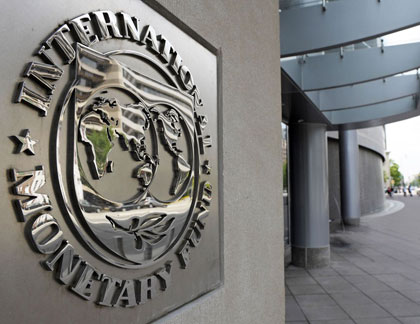An International Monetary Fund (IMF) mission, led by Jan Kees Martijn, visited Bucharest and Cluj-Napoca from September 22 to October 4 to conduct discussions on the 2023 Article IV Consultation with Romania. The mission has issued the following statement:
Romania has weathered the economic shocks from the pandemic, Russia’s war in Ukraine, and the resulting surges in energy and food prices relatively well. The country has continued its convergence to higher incomes of EU peers. The main policy challenge is to put the public
finances on a sustainable path.
• The recently adopted fiscal package is an important first step to reduce the high fiscal deficit. However, further ambitious tax reforms are needed to rebuild fiscal space, make the tax system fairer and more efficient, and raise revenues to strengthen public services.
• In addition, fiscal policy needs to become more predictable. Establishing a credible path for medium term fiscal consolidation will help secure market financing at lower borrowing costs. Announcing further tax reforms well in advance will help companies and workers
adjust to these changes.
• Following the tightening of monetary policy, inflation is trending down. Monetary policy should not be relaxed until core inflation is on a firm downward path as needed for returning headline inflation to within the National Bank of Romania’s (NBR) tolerance band around the target by mid-2025.
• Structural reforms need to address governance weaknesses and improve public service delivery. A major effort is needed to support Romania’s transition to a carbon-neutral economy.
After a robust performance during 2022, growth slowed in the first half of 2023. The slowdown was mostly driven by weaker consumption, as high inflation eroded real wages. In the meantime, public and private investment have remained strong. Inflation peaked in November 2022, and has since been declining steadily, driven by base effects, receding energy and food prices, an easing of supply bottlenecks, and monetary tightening. The current account deficit remains large, but is declining and is mostly financed by EU grants and direct
investment inflows. International reserves remain adequate.
Outlook and Risks
Despite the slowdown, growth is expected to remain fairly robust, and higher than in most peers. In 2023, growth is projected at 2¼ percent, supported by strong investment. In 2024, the economy is expected to recover modestly to growth of around 2¾ percent as stronger real wages and external demand are partially offset by the necessary fiscal consolidation. In the medium term, the economy is expected to return to its potential growth rate of 3¾ percent as consumption recovers, and investment, underpinned by Recovery and Resilience Facility funds, remains strong. With the weakening of economic growth, inflation is expected to decelerate from 7½ percent at end-2023 to 4½ percent by end-2024, still well above the NBR’s inflation target band.
The risks surrounding this outlook are substantial. Russia’s war in Ukraine, a possible further weakening of activity across Europe, or an abrupt global slowdown could undermine growth and capital flows to emerging markets. Strong wage growth in Romania could delay
the projected fall in core inflation. Finally, it could be challenging to implement fiscal consolidation and the next steps under the National Recovery and Resilience Plan (NRRP) during a year with multiple elections.
Policy Priorities
The recently adopted fiscal package is a step in the right direction but further adjustment is needed. The original deficit target for 2023 of 4.4 percent of GDP is now likely out of reach, and we project a deficit of 6 percent of GDP. The new fiscal package will improve public finances in 2024 and beyond by about 1 percent of GDP, resulting in a deficit of just above 5 percent of GDP in 2024. However, fiscal deficits will need to fall below 3 percent of GDP, as agreed with the European Commission, to stabilize public debt over the medium term, help secure necessary market financing at lower interest rates, and support ongoing disbursement of EU funds. Additional adjustment by at least 2 percent of GDP in the next few years will be needed to achieve this.
The new tax package improves policy design in some areas. It broadens the tax base and improves revenues by limiting exemptions for workers in the agricultural, construction, food processing and IT sectors, and by limiting the number of goods subject to reduced VAT rates.
These measures improve fairness and support fiscal adjustment in a growth-friendly way. The increase in the microenterprise tax will raise tax revenue; but to really close this loophole, the threshold for registering as a microenterprise should be reduced further. In addition, the
turnover taxes on banks and large enterprises put an unfair burden on companies with low margins and may reduce financial intermediation.
The scope to achieve further fiscal adjustment via reductions in spending or increasing expenditure efficiency is limited. Ongoing spending reviews are welcome and could help streamline government expenditures over time but are unlikely to offer large savings.
Furthermore, supporting an ageing population, addressing social needs, and improving public services—especially education and healthcare—towards EU standards, require well-targeted and adequate spending.
Further tax reforms are needed to increase revenue, efficiency, and fairness. An increase in revenues of more than 2 percent of GDP beyond the gains from the recent tax package will be needed over the next two years. To this end, key measures to consider are (i) elimination of remaining exemptions, privileges and loopholes; (ii) further VAT streamlining; (iii) implementing the reformed property tax; and (iv) using tax policy to promote the efficient use of energy and, more broadly, foster the transition to a carbon-neutral economy. Ongoing improvements in revenue administration, while needed, do not offer quick or predictable results, and cannot be relied on to achieve the necessary near-term fiscal adjustment.
Fiscal policy also needs to be well planned and clearly communicated to provide predictability for households and firms. Ad-hoc tax changes in response to urgent fiscal needs create uncertainty and undermine the ability to plan. In this regard, the establishment of a tax policy unit in the Ministry of Finance is welcome. It should help develop a medium-term revenue strategy, and plan, design, and analyze tax policies well in advance of their enactment and implementation. Increased predictability of spending on public sector wages and pensions is also important, and the planned reforms in these areas in the context of the NRRP are vital. These steps would help improve medium-term budgeting.
Monetary and Financial Sector Policies
While price pressures have begun to moderate, the NBR should maintain a cautious approach to ensure inflation returns to within the tolerance band around the target by mid-2025. Monetary policy tightening has helped reduce inflation and keep inflation expectations anchored. Looking forward, the NBR’s public commitment to keep rates on hold through 2023 is appropriate in light of still-elevated core inflation and upside risks from rising wages. A relaxation of monetary policy should wait until core inflation is on a firm downward
path such that the target range is clearly within reach. Moreover, there is a strong case for implementing any reduction in interest rates in a gradual manner, given the high uncertainty about the inflation process, monetary transmission, and fiscal policies. In case of a meaningful
upward revision of projected core inflation, the NBR should stand ready to tighten monetary policy, including liquidity management, as needed. The government’s price controls for food items, on the other hand, are not a suitable instrument for lowering inflation as they can
compress supply and raise prices of other goods.
Romania’s monetary policy framework, with a relatively stable exchange rate to the euro, supported price stability in the decade prior to the pandemic, despite challenges arising from a small financial sector, partial euroization, and volatile capital flows. A gradual increase in two-way exchange rate flexibility over the medium term would limit opportunities for destabilizing capital flows, increase monetary policy effectiveness, and enhance resilience to economic shocks. In conjunction with fiscal consolidation, it would also help strengthen Romania’s weak external position.
The banking system maintains its overall strong capital, liquidity, and profitability positions. The tightening of macroprudential policies—including raising the countercyclical capital buffer —has appropriately supported monetary policy and reduced risks in the financial
sector. The banking sector will be further strengthened through ongoing consolidation.
Emerging risks from the recent surge in FX borrowing and the impact of the planned tax on banks should be monitored. Banks and supervisors should scrutinize FX borrowing by non-financial corporations and ensure it is appropriately hedged. The planned turnover tax
on banks could undermine already-weak financial intermediation and gradually weaken financial buffers.
Structural Reforms and the Green Transition
The NRRP provides an important opportunity for advancing structural reforms. In addition to fiscal structural reforms, it envisages governance and administrative reforms to increase transparency, strengthen public sector efficiency (including through digitalization),
and improve the monitoring of state-owned enterprises. Decisive actions along these lines would also help boost EU-funded investment. In this context, the mission welcomes the government’s focus on increasing the absorption of EU funds.
Raising labor force participation (LFP) is important in light of Romania’s ageing and declining population. Romania’s LFP is among the lowest in the EU, and policies focused on helping women work in the formal economy through better availability of childcare and parttime jobs would help sustain growth, ease labor shortages, and reduce inequality. Investing in the quality of education—where Romania lags EU peers—would also help raise labor supply and productivity.
Romania, with its large potential for renewables, is well-positioned to benefit from decarbonization and become more competitive in green value chains. Romania’s electricity production is already dominated by low-carbon sources. Nonetheless, achieving carbon neutrality and ensuring energy security, in part by exploiting the natural gas resources in the Black Sea, will require large investments. The NRRP offers significant resources to phase out coal and expand the power grid. In addition, the authorities should make greater use of tax instruments to support the green transition. It will also be vital to preserve social balance, including by supporting vulnerable workers and lower-income households that face cost increases.


COMMENTS